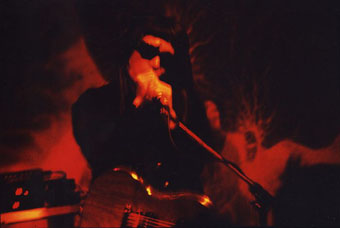 |
Fushitsusha |
Haino took the stage first, billed under his band name Fushitsusha (“The Unlost”), despite the fact this was a solo performance (bassist Yasushi Ozawa was ill). Though Haino apparently loathes the categorisation of their style as ‘improvised’, his performances with Fushitsusha (often labelled “the heaviest rock band on planet earth”) have come to signify a critical peak for free rock.
Without the other members, though, Haino was reduced to playing with a drum machine and loops created from his own guitar and a theremin-like device. Despite this, the solo performance was still an extraordinary event. Cutting a numinous figure in his trademark black leather pants, billowing black shirt and dark sunglasses, surrounded by a thin haze of incense smoke, Haino unleashed an unearthly aural assault that ranged from tiny jagged echoes to an almost overwhelming electric cacophony of guitar wails, potent feedback and roaring distortion.
During the performance Haino’s face, framed by long black hair and a thick fringe, was a picture of intensity. Hurling his body, dervish-like, across the stage, he assailed both guitar and microphone with ferocity, producing a turbulent, driving din. At one point his body was propelled backwards into the speakers, recoiling from the force of his attack on his visibly scarred guitar. Later he lurched dangerously close to the edge of the stage. Haino’s convulsive thrashing lead to a trail of dropped picks across the stage, patches of abrupt silence (filled with cheers and applause) as he became unplugged and, by the end, a guitar bereft of most of its strings.
In between violent guitar flagellation and anguished screams came small moments of quiet, as Haino whispered, hissed and gagged on agonised lyrics. It’s this mix of ear-splitting tone and volume with soft, textured sounds for which Fushitsusha is famous and which demonstrates Haino’s incredible noise-making range.
In contrast to the maniacal, ostentatious sensuality of Haino’s performance, Masami Akita (Merzbow) presented a more introverted, almost wraithlike image. His method revolved around the meticulous addition and layering of sounds. Where Haino screamed, stalked the stage and stamped on pedals, Merzbow barely moved. Framed behind a pair of laptop screens casting a ghostly blue glow on his pale face and glasses, the only movement was the occasional twitch of an index finger on the mouse or mixer and his eyes flicking between screens.
Layer on layer, Merzbow created a soundscape that began with faint twittering and fluttering and rain-like static, joined by a swelling bassline and samples of chains and other metallic scrapings. The sounds accreted over time, swirling and shifting, pulsing louder and softer. Harsh, grinding crunches were counterpointed with delicate tinkles, until the final buffeting climax. An oceanic mix of soaring and dipping sounds, the performance was notably quieter than some of his more violent pieces, but no less complex.
The differences between the 2 performers embody the cleavage between rock, with its emphasis on liveness and authenticity, and the related but very different sound-art world, which usually eschews drama and staging in favour of restrained, anti-spectacular delivery. These discursive differences in performance are deeply imbricated with the production of the music itself. Haino’s demented energy, frenzied strumming and throat-tearing howls perfectly enact rock’s myth of authenticity. His spasmodic convulsions are the result of total surrender to the power of the unmediated, pure, raw sound. In contrast, Merzbow’s rejection of ‘performance’ and careful accretions typify sound art’s minimalist syncretic-assemblage approach.
Romanticism emphatically informs Haino’s performance, where the music offers immediate, unmediated access to the artist’s genius-soul, while Merzbow’s approach is rooted in Surrealism. Taking his name from a Kurt Schwitters painting (The Cathedral of Erotic Misery), his music-making and artistic persona is constructed around Surrealism’s obsession with the unconscious. Merzbow sees his sonic collages, with their approximation of the dream state, as a form of automatic writing.
Coming together for What is Music?, these performers’ differences synthesized into a deafening, caterwauling crescendo. The resulting industrial collage of electronic noises, distortions and unearthly vocals provided a fitting end to 2 consummate performances from exemplars of interlocking but distinct modes of experimental music making.
What is Music? Haino Keiji (as Fushitsusha) and Masami Akita (as Merzbow), Brisbane Powerhouse, Feb 7
RealTime issue #60 April-May 2004 pg. 46
© Danni Zuvela; for permission to reproduce apply to [email protected]








 back
back